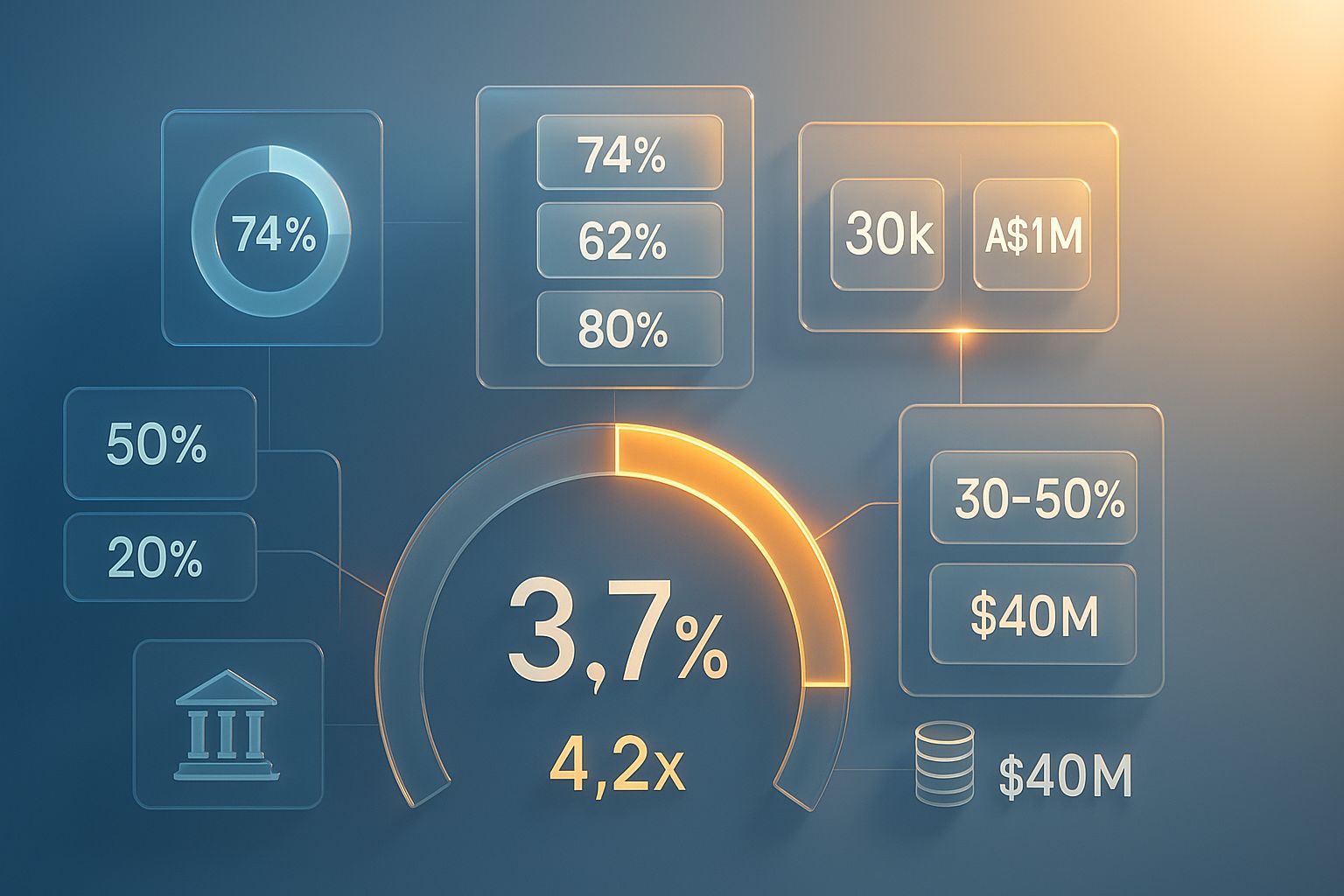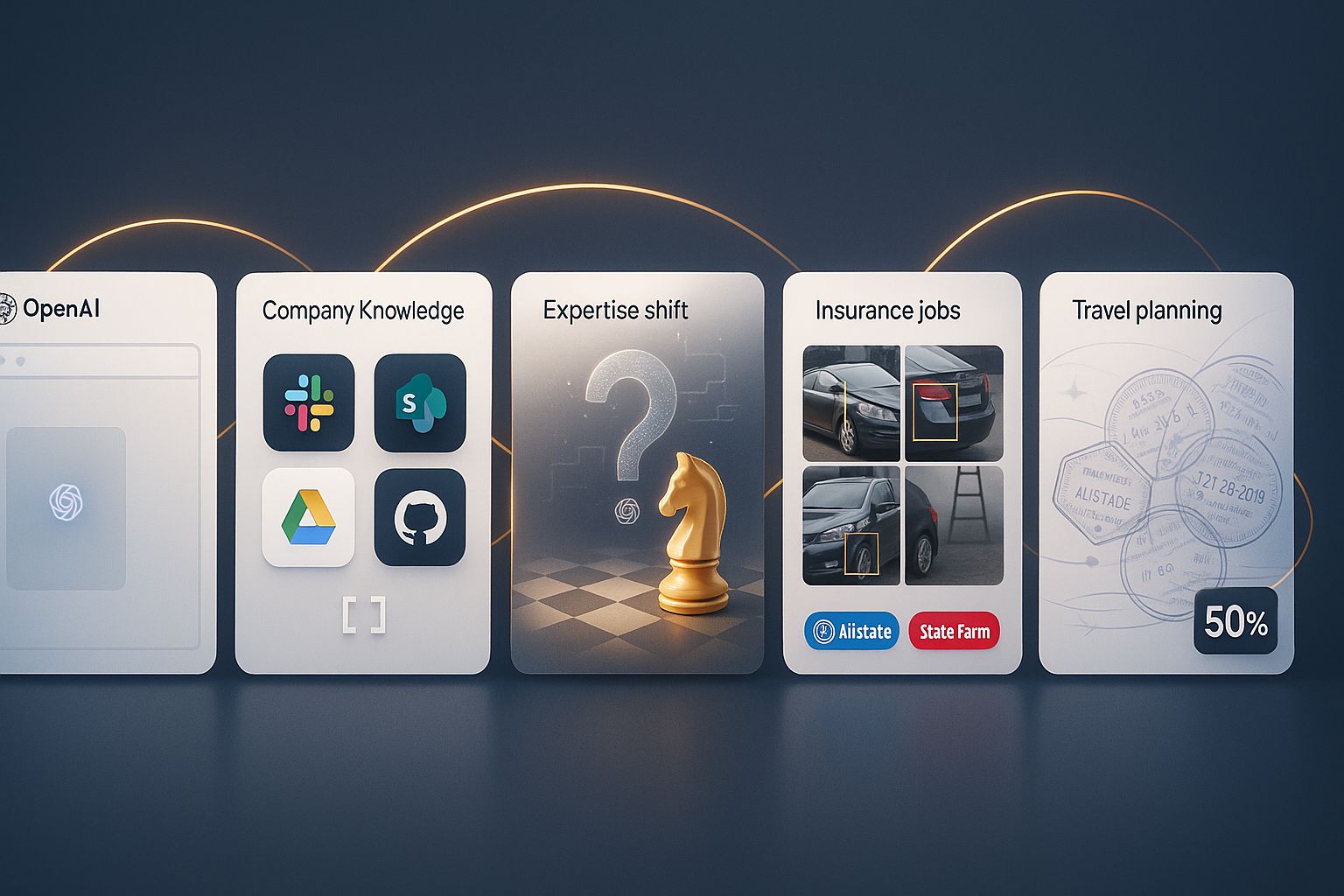AI’s Back-Office Revolution: Transforming Enterprise Efficiency Silently
💼 The Back-Office Dividend: Where AI Delivers Its Biggest Returns
While enterprises chase customer-facing AI innovations, the real transformation is happening behind the scenes. Banks are cutting loan processing times by 20% through intelligent document processing. Canva expects to save 30,000 work hours in 2025, translating to A$1 million in returns. Mondelez is slashing marketing production costs by 30-50% through generative AI tools for content creation.
The pattern is unmistakable: AI's highest returns aren't coming from chatbots and recommendation engines. They're emerging from the middle and back offices—document processing, compliance workflows, financial reconciliation, marketing production, and operational coordination. McKinsey research confirms that 75% of GenAI's value concentrates in customer operations, marketing, software engineering, and R&D—predominantly operational functions.
This matters because most AI strategies remain fixated on customer experience while underinvesting in the operational backbone where measurable business impact accumulates. The companies capturing disproportionate value understand that back-office transformation creates the capacity and capital efficiency that funds innovation elsewhere. Goldman Sachs CEO David Solomon frames it plainly: "AI gives us more capacity to invest in our business"—not through headcount reduction, but by automating processes and reinvesting efficiency gains into growth.
The back-office dividend isn't about replacing people. It's about reclaiming human capacity from repetitive work and redeploying it toward judgment, strategy, and relationship-building that drive competitive advantage.
Let's dive in.

🎯 The Efficiency Multiplier: Why Operational AI Outperforms Customer-Facing Flash

The narrative around AI has focused relentlessly on the customer-facing promise: personalized experiences, predictive recommendations, conversational interfaces that delight users. Meanwhile, the actual returns are piling up in places customers never see.
Consider the banking sector. AI transformation of back-office operations delivers continuous, scalable value through document processing, account opening automation, payment investigations, and regulatory compliance. Banks achieve 97% extraction accuracy while reviewing documents 50% faster and reducing loan fulfillment times by 20%. Account opening accelerates 35-50% through automated KYC/AML processes. Payment investigations close 40% faster through automated case routing and SWIFT message summarization.
These aren't incremental improvements. They represent fundamental reconfigurations of operational cost structures. When reconciliation processes achieve 97% accuracy while handling exceptions 75% faster, when regulatory compliance cycles compress by half, when new product launches accelerate by 30%—these gains compound. They free capital, reduce risk, and create capacity for strategic initiatives that drive growth.
The ROI Reality Check
Enterprise GenAI delivers an average return of $3.70 per dollar invested, with financial services seeing returns as high as 4.2×. But this value is concentrated. McKinsey data shows 75% of GenAI's economic potential clusters in customer operations, marketing and sales, software engineering, and R&D—functions that blend customer-facing and operational work, with the operational components driving measurable efficiency.
The gap between pilot and production reveals the same pattern. MIT research found 95% of GenAI pilots fail to deliver measurable returns—not because technology doesn't work, but because organizations struggle to scale. Yet companies that focus on operational workflows with clear metrics see rapid adoption. Healthcare organizations moved 62% of use cases into production, with 80% reaching production within six months. The difference? Operational applications have defined processes, measurable outputs, and existing workflows to enhance rather than invent.
Lenovo's research projects agentic AI will double workforce productivity by 2027, with current generative AI already delivering $4 in return for every $1 invested. These gains emerge from operational automation: AI PCs with dedicated processors reducing support tickets by 30%, TruScale Device as a Service cutting per-seat expenses by 57%, and agentic AI capabilities saving enterprises measurable person-hours through workflow automation.
The Capacity Economics
Goldman Sachs articulates the strategic logic: operational AI creates capacity to invest in growth, not just cost reduction. When AI automates routine processes—document compilation, data reconciliation, compliance reporting—it doesn't eliminate jobs. It eliminates the 51% of time knowledge workers spend on low-value tasks, the primary cause of burnout for 85% of employees.
This capacity translates directly to competitive advantage. Professionals freed from mechanical work focus on client relationships, strategic analysis, and creative problem-solving that AI can't replicate. The firm's "One Goldman Sachs 3.0" initiative reimagines processes end-to-end, channeling efficiency gains back into business expansion rather than banking cost savings.
Canva's implementation demonstrates this principle at scale. The design platform expects to save 30,000 person-hours in 2025 through agentic AI features, with an annualized return of A$1 million. But Canva isn't limiting AI to high-return projects—they're encouraging experimentation to maximize learning. All staff have access to Google's Gemini, with ChatGPT and other tools available on request. The goal: making AI part of everyone's mindset while systematically building capability across the organization.
The agentic AI projects deliver specific operational improvements: Slack channel monitoring that answers expense reimbursement queries correctly 60% of the time (escalating to Jira tickets when it can't), call-preparation assistants that automatically update Salesforce records post-conversation, and LLM-powered workflow steps that broaden automation beyond core business processes into experimental applications.
The Production Proof
What separates operational AI success from customer-facing struggles? Three factors:
Clear metrics: Operational work has defined inputs, processes, and outputs. Document processing accuracy, cycle time reduction, error rates—these metrics are objective and measurable. Customer satisfaction, engagement, delight—these remain subjective and difficult to attribute to specific AI interventions.
Existing workflows: Back-office operations have established processes to enhance. AI doesn't need to create new behaviors or convince skeptical users to adopt unfamiliar patterns. It accelerates, automates, and improves what already exists.
Immediate value: Operational improvements deliver tangible results quickly. A 40% reduction in payment investigation time shows up in quarterly metrics. Enhanced customer experience might take years to manifest in retention or lifetime value.
Mondelez's approach illustrates strategic operational AI. The company invested over $40 million in a generative AI tool developed with Publicis Groupe and Accenture, targeting 30-50% cost reductions in marketing content production. The tool already produces social media content for Chips Ahoy in the U.S. and Milka in Germany. By next holiday season, Mondelez expects to produce short TV ads ready for airing, potentially including 2027 Super Bowl content.
The operational focus extends to Amazon and Walmart product pages by November, with expansion to Brazil and UK markets in coming months. Importantly, humans review all AI-generated content, with explicit rules prohibiting unhealthy eating promotion, vaping references, overconsumption, emotionally manipulative language, and offensive stereotypes. This governance enables scale while maintaining brand integrity.
The cost mathematics are striking: traditional animation production runs "in the hundreds of thousands" of dollars. AI-generated alternatives are "orders of magnitude smaller." This isn't marginal improvement—it's fundamental cost structure transformation that frees budget for strategic creative work and market expansion.
The Strategic Implication
Healthcare's AI adoption trajectory reinforces the operational advantage. The sector, traditionally slow to adopt digital innovation, is now deploying AI at more than twice the rate of the broader economy. Healthcare spending on AI reached $1.4 billion in 2025, nearly tripling the previous year's investment. Startups capture 85% of this spending, with the emergence of healthcare AI unicorns signaling sustained momentum.
The applications driving adoption? Automating manual workflows, improving patient engagement, enhancing drug discovery processes. These are operational improvements that deliver measurable efficiency, cost reduction, and outcome improvements. The 74% of health executives reporting positive ROI aren't doing so because AI improved patient experience (though it has). They're reporting ROI because AI reduced administrative burden, accelerated clinical workflows, and enhanced operational coordination.
📌 Bottom Line: AI's back-office dividend outpaces front-office innovation because operational work has clear metrics, established workflows, and immediate measurable value. Organizations that recognize this pattern invest strategically in the middle and back offices, creating capacity and capital efficiency that funds customer-facing innovation. Those chasing only the customer experience miss where AI delivers its highest returns.

🏭 AI Across Industries

🏦 Banking: The Silent Transformation
While fintech disruption captures headlines, traditional banks are quietly reengineering their operational cores. The transformation spans nine critical functions delivering measurable returns without customer-facing fanfare.
Lending operations achieve 97% extraction accuracy, with loan officers reviewing documents 50% faster and fulfillment times dropping 20%. Account opening automation through KYC/AML processes enables compliance teams to work 35-50% faster. Payment investigations accelerate 40% through automated case routing and SWIFT message summarization.
Trade reconciliation achieves 97% accuracy while managing exceptions 75% faster, reducing operational risk. Compliance horizon scanning automatically summarizes regulations and assesses impact, cutting time-to-decision by half. New product launches accelerate 50% through AI-generated specifications, marketing materials, and regulatory filings, with decision cycles compressing 30%.
📌 Takeaway: Banking's AI transformation happens behind the scenes, where document processing, compliance workflows, and reconciliation deliver continuous efficiency gains that compound into significant competitive advantages.
🏥 Healthcare: Operations Over Algorithms
Healthcare's AI revolution is fundamentally operational, not diagnostic. The sector's rapid adoption—deploying AI at twice the rate of the broader economy—stems from workflow improvements delivering immediate measurable value.
Healthcare spending on AI reached $1.4 billion in 2025, nearly tripling from 2024, with startups capturing 85% of spending. The 74% of health executives reporting positive ROI see operational efficiency reducing administrative costs and accelerating clinical workflows. Organizations moved 62% of use cases into production, with 80% reaching production within six months.
AI workflow automation now handles appointment scheduling, prescription refills, insurance verification, claims processing, and follow-up reminders—administrative tasks consuming clinical staff time without requiring medical judgment. Revenue cycle management AI identifies billing errors, optimizes coding, and accelerates claims processing. Care coordination platforms ensure seamless information flow across departments.
📌 Takeaway: Healthcare's AI success stems from operational applications that reduce administrative burden and improve coordination—freeing clinical staff to focus on patient care requiring human expertise.
💼 Professional Services: Augmentation Through Automation
Professional services transformation reveals how operational AI creates capacity for strategic work. Across architecture, engineering, surveying, and project management, AI automates tasks that once required exclusively human effort.
Architectural design tools handle generative design and drafting automatically. Project planning AI optimizes timelines and resource allocation. Quantity surveying automation performs take-offs and budgeting, boosting efficiency by 50%. Construction management systems use drones and AI vision to monitor site progress and safety in real time.
The critical insight: AI handles data synthesis, pattern recognition, and structured output generation—freeing architects, engineers, and project managers to focus on design innovation, client relationships, and judgment calls defining project success.
The challenge: implementation lags behind ambition. A July 2025 MIT study found AI investments fail to deliver value when organizations lack skills and culture to use technology effectively. The Built Environment Futures Assembly responds by embedding AI literacy into curricula and continuous professional development.
📌 Takeaway: Professional services AI creates value by automating structured tasks, enabling focus on judgment and creativity—but only when organizations invest in workforce readiness alongside technology.
🛒 Retail: The Automation Imperative
Retail automation delivers speed, accuracy, and efficiency during high-demand periods while future-proofing operations. The business case centers on operational advantages rather than customer experience enhancements.
Modern automation tools deploy within weeks or days without major operational overhauls. AI-driven inventory systems, automated replenishment, and smart checkout solutions enable retailers to head into 2026 with leaner operations and more efficient teams.
Warehouse automation demonstrates ROI: Dexory's robot scans 10,000 pallet locations per hour for real-time visibility. Time savings on cycle counts and error investigations are transformative. Error reduction prevents disruptions across picking and put-away processes, maintaining operational flow.
Retailers implementing automation now gain advantages during peak shopping periods while gathering performance data informing 2026 strategy. Starting with highest-impact areas—inventory management, fulfillment, customer service—creates efficiencies that scale into major gains.
📌 Takeaway: Retail automation delivers immediate operational returns through speed, accuracy, and resource optimization—enabling efficient peak demand handling while building foundations for sustained growth.

📊 AI by the Numbers

💰 $3.70 average return per dollar invested in GenAI, with financial services seeing returns as high as 4.2×—demonstrating that operational AI delivers measurable ROI when properly implemented (McKinsey)
⚡ 30,000 work hours saved by Canva in 2025 through agentic AI features, translating to A$1 million annualized return—showing how operational automation creates tangible financial impact (Workato/Canva)
📈 97% extraction accuracy achieved in banking document processing, with documents reviewed 50% faster and loan fulfillment times reduced 20%—illustrating AI's precision in operational workflows (Multiple banking implementations)
🏥 74% of healthcare executives report positive ROI from AI deployments, with 62% moving use cases into production and 80% reaching production within six months (Google Cloud Survey/Menlo Ventures)
💼 30-50% reduction in marketing production costs achieved by Mondelez through generative AI tools for content creation, with investment exceeding $40 million (Mondelez/Publicis/Accenture)

📰 Five Headlines You Need to Know

🌐 OpenAI Launches Atlas Web Browser with AI Integration
OpenAI's Chromium-based Atlas browser integrates ChatGPT directly into browsing, enabling users to query AI about web pages through an "Ask ChatGPT" sidebar. The initial Mac release includes Agent mode for autonomous task handling, with Windows and mobile versions planned. The browser features incognito browsing, optional memories for personalization, and promises not to use browsing data for model training unless users opt in. OpenAI is expanding beyond pure AI into platform strategy, with Atlas joining ChatGPT Pulse, Sora app, and e-commerce integrations with Etsy and Shopify.
🧠 OpenAI's Company Knowledge Transforms Enterprise ChatGPT
ChatGPT Business, Enterprise, and Edu users can now integrate context from connected apps—Slack, SharePoint, Google Drive, GitHub—directly into ChatGPT responses. Powered by GPT-5, the system searches multiple sources simultaneously to provide comprehensive answers with clear citations. The feature respects existing company permissions, maintaining security while enabling AI to access authorized information. Use cases include synthesizing customer feedback from multiple channels for product roadmaps, creating campaign reports from CRM and document data, and building release plans from GitHub, Linear, and Slack engineering channels.
💼 Rethinking Professional Expertise in the Age of AI
As AI democratizes access to information, the value of expertise shifts from content provision to context interpretation. A CEO's question captures the dilemma: if junior analysts access the same AI insights as senior strategists, why pay for expertise? MIT Sloan research identifies three critical transformations: from answers to questions (identifying unasked questions and unknown unknowns), from information to judgment (bearing the weight of consequential decisions), and from static to liquid knowledge (dynamically reshaping information based on context). Leaders must develop team meta-expertise—the ability to orchestrate AI tools, synthesize information across domains, and make creative connections algorithms cannot.
🏥 AI Quietly Transforms Insurance Industry Jobs
Artificial intelligence is reshaping insurance white-collar work through automation of structured tasks: data processing, claims intake, customer service, and underwriting support. Evercore ISI research analyzing 160 million jobs finds insurance among industries most exposed to AI transformation, with 80% of workers having at least 10% of daily tasks automatable. Companies like Allstate and State Farm already use AI to analyze damage photos and flag potentially fraudulent claims. The shift compresses career ladders—entry-level roles thin out while veteran duties narrow—potentially eroding the apprenticeship model that sustained the industry. The challenge: maintaining human expertise development while automating traditional training ground functions.
🏨 AI Reshapes Travel Planning and Booking Behavior
Marriott Bonvoy research of 22,000 travelers across EMEA reveals 50% now use AI for holiday planning, up from 41% last year and 26% two years prior. Half of respondents say they'd feel comfortable booking accommodation through AI platforms in the future. The rise of AI accompanies new travel trends: "lux-scaping" (booking luxury stays at trip start or end) practiced by 59% of travelers, "passion pursuits" (holidays centered on music, sports, or cultural events) embraced by 68%, and "country hopping" (visiting multiple countries in one trip) planned by 52% for 2026. The research demonstrates AI's integration into consumer decision-making while highlighting emerging travel patterns that blend technology with experiential priorities.

🎯 Final Take: The Business Case for Agents

The back-office dividend represents AI's most tangible value creation. While customer-facing applications remain stuck in pilot purgatory, operational improvements deliver immediate measurable returns: 50% faster document processing, 30-50% cost reductions, 30,000 work hours reclaimed.
This pattern holds across sectors. Banking automates compliance and reconciliation. Healthcare captures 74% ROI from workflow automation. Professional services augment rather than replace expertise. Retail optimizes fulfillment and inventory.
The strategic implication: AI investment should flow toward operational excellence before customer experience innovation. Not because customer experience doesn't matter, but because operational efficiency creates the capacity and capital to fund strategic initiatives. Goldman Sachs CEO David Solomon articulates this explicitly: "AI gives us more capacity to invest in our business." The efficiency gains don't reduce headcount—they redeploy human capability toward judgment, creativity, and relationships that drive growth.
The organizations capturing disproportionate value recognize that back-office transformation isn't about making invisible work more invisible. It's about converting operational excellence into strategic advantage—freeing resources, reducing costs, accelerating timelines, and creating capacity for innovation that competitors constrained by operational inefficiency cannot match.
As intelligence becomes ambient, the question isn't whether to deploy AI. It's where to deploy it first. The evidence suggests starting where returns are highest, metrics are clearest, and workflows are most established: the back office that everyone overlooks but no business can function without.
📩 Ready to Build Your Agentic Strategy?
🎯 At Velocity Road, we help mid-market companies identify and capture operational AI opportunities that deliver measurable ROI. We assess workflows, build implementation roadmaps, and establish governance frameworks that enable systematic value creation.
Let's discuss how we can accelerate your AI transformation—schedule a consultation today.
📬 Forward this newsletter to colleagues who need to understand AI's production reality. And if you're not subscribed yet, join thousands of executives getting weekly intelligence on AI's business impact.




